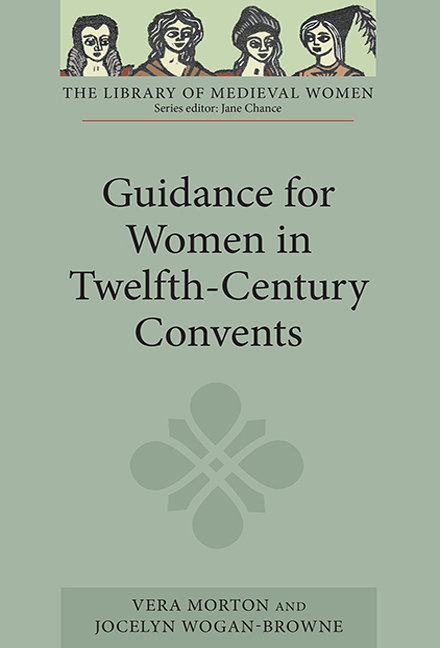Book contents
- Frontmatter
- Contents
- Preface
- Acknowledgements
- Abbreviations
- Introduction
- Note on Texts and Translations
- I Osbert of Clare, Prior of Westminster, to Adelidis, Abbess of Barking: A Thank-You Letter on Holy Widows, Virgin Fecundity and Precedents for Female Authority (Letter 42)
- II Abelard to Heloise: The History of Women's Roles in Christianity (Letter 7)
- III Peter the Venerable to his Nieces Margaret and Pontia: Of Nieces and Grandmothers and the Virgin Life at Marcigny (Letter 185)
- IV Osbert of Clare to his Nieces Margaret and Cecilia in Barking Abbey: Heavenly Rewards for Virgins in Barking (Letters 21 and 22)
- V Abelard to Heloise: On Educating Virgins (Letter 9)
- VI Goscelin of St Bertin: Lives of the Abbesses at Barking (Extracts)
- Interpretive Essay
- Bibliography
- Index
- Index
- Miscellaneous Endmatter
IV - Osbert of Clare to his Nieces Margaret and Cecilia in Barking Abbey: Heavenly Rewards for Virgins in Barking (Letters 21 and 22)
Published online by Cambridge University Press: 29 April 2017
- Frontmatter
- Contents
- Preface
- Acknowledgements
- Abbreviations
- Introduction
- Note on Texts and Translations
- I Osbert of Clare, Prior of Westminster, to Adelidis, Abbess of Barking: A Thank-You Letter on Holy Widows, Virgin Fecundity and Precedents for Female Authority (Letter 42)
- II Abelard to Heloise: The History of Women's Roles in Christianity (Letter 7)
- III Peter the Venerable to his Nieces Margaret and Pontia: Of Nieces and Grandmothers and the Virgin Life at Marcigny (Letter 185)
- IV Osbert of Clare to his Nieces Margaret and Cecilia in Barking Abbey: Heavenly Rewards for Virgins in Barking (Letters 21 and 22)
- V Abelard to Heloise: On Educating Virgins (Letter 9)
- VI Goscelin of St Bertin: Lives of the Abbesses at Barking (Extracts)
- Interpretive Essay
- Bibliography
- Index
- Index
- Miscellaneous Endmatter
Summary
At the end of Osbert's letter to the abbess Adelidis (I above) he tcommends his two nieces, Margaret and Cecilia, to her; he calls them daughters of his sister, and they were presumably already nuns of Barking, but apart from this we know nothing of them. However, the two letters to Margaret and Cecilia differ in style and though it is dangerous to read personal feelings into such letters, it is tempting to imagine that the young women were different in character and Osbert perceived that they required different kinds of exhortation.
The letter to Margaret was written before Osbert's journey to Rome, probably in 1139. It is characterized by a feeling of personal interest and affection, and omits all reference to the spectacular accounts of St Margaret and the dragon and the tortures of her passion in the contemporary lives of this well-known saint. Osbert confines himself to the gentlest account of the meaning of the name, Margaret, and its beauties as ‘pearl’ (Latin margarita). The use of precious stones as symbols of virtues is common, and a special theme of virginity and chastity literature. The name Margaret was a favoured occasion for symbolic etymology among writers of saints’ lives and devotional literature. Here, the use of the pearl as a symbol of virtues serves to distance Osbert's niece Margaret from the harshness of life. Sinners draw upon themselves the punishment of heaven, but there is scarcely any suggestion that the nun, Margaret herself, could have been touched by sin. Osbert's advice, ‘as often as any troublesome thought comes to you, set this letter before you’ is mild and gentle by comparison with his letters to Adelidis and to Cecilia.
Although it was probably written only a year later, in 1140 after Osbert's return from Rome, the Letter to Cecilia is different in tone from that written to Margaret. Where the Letter to Margaret focuses on the spiritual virtues symbolized by the pearl of virginity, the Letter to Cecilia presents the virgin life as a form of spiritual marriage. The profession of virginity or chastity is taken as a solemn nuptial vow and the joys of heavenly marriage are opposed to the disadvantages of union with an earthly bridegroom. We are reminded very strongly in this letter in particular that chastity was seen as a positive and desirable thing, a privilege and not a misfortune.
- Type
- Chapter
- Information
- Guidance for Women in Twelfth-Century Convents , pp. 109 - 120Publisher: Boydell & BrewerPrint publication year: 2003



